|
|
General: 1ST JYOTIRLINGA - SOMNATH TEMPLE
Elegir otro panel de mensajes |
|
|
| De: luistovarcarrillo (Mensaje original) |
Enviado: 04/12/2009 14:35 |
ॐ सांई राम
|  Today we will be starting to visit all the 12 sacred Jyotirlingas of India.May Sai help us to complete this teerth Yatra and pay our respects to all the holy shrines and temples of the world. Today we will be starting to visit all the 12 sacred Jyotirlingas of India.May Sai help us to complete this teerth Yatra and pay our respects to all the holy shrines and temples of the world.
 Shree Somnath is first among the twelve Aadi Jyotirlings of India. It is the holy place of the Aadi Jyotirling Shree Somnath Mahadev and it also has the sacred soil from where Bhagvan Shri Krishna took his last journey to his neejdham.  Ancient Indian traditions maintain a close relationship of Somnath with release of Chandra (Moon God) from the curse of his father-in-law Daksha Prajapati. Moon was married to Twenty-Seven daughters of Daksha. However, he favoured Rohini and neglected other queens. The aggrieved Daksha cursed Moon and the Moon lost power of light. With the advice of Prajapita Brahma, Moon arrived at the Prabhas Teerth and worshipped Bhagvan Shiva. Pleased with the great penance and devotion of Moon, Bhagvan Shiva blessed him and relieved him from the curse of darkness partially, thus causing the periodic waning of moon. . Pauranic traditions maintain that Moon had built a golden temple, followed by a silver temple by Ravana, Bhagvan Shree Krishna is believed to have built Somnath temple with Sandalwood. Located as it is, it is widely believed that if one were to sail from here in a straight line, the end of the journey would be at the North Pole, without having to travel over land. 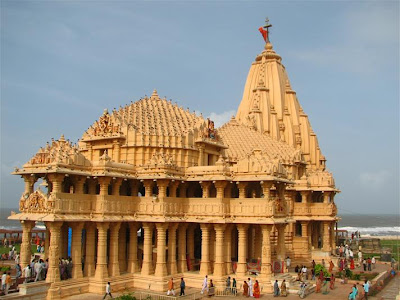 The research based on ancient Indian classical texts show that first Somnath Jyotirling Pran-Pratistha was done on the auspicious third day of brighter half of Shravan month during the tenth Treta yug of Vaivswat Manvantar. Swami Shri Gajananand Saraswatiji, Chairman of Shrimad Aadhya Jagadguru Shankaracharya Vedic Shodh Sansthan, Varanasi suggested that the said first temple was built 7,99,25,105 years ago as derived from the traditions of Prabhas Khand of Skand Puran. Thus, this temple is a perennial source of inspiration for millions of Hindus since time immemorial. 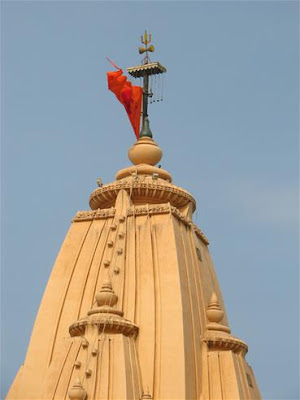 The later sources of history account for several desecrations by Muslims invaders during eleventh to eighteen century A.D. The temple was rebuilt every time with the reconstructive spirit of the people. The modern temple was reconstructed with the resolve of Sardar Patel who visited the ruins of Somnath temple on November 13 1947. Then President of India, Dr. Rajendra Prasad, did the Pran-Pratistha at the existing temple on 11 May 1951. 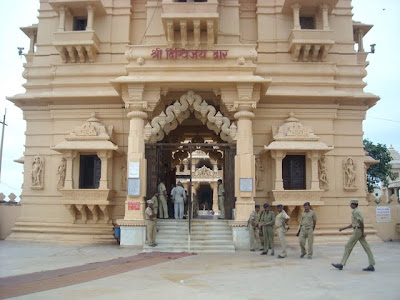 Somnath temple stands at the shore of the Arabian ocean on the western corner of Indian subcontinent in Gujarat State. This pilgrimage is one of the oldest and finds its reference in the ancient texts like Skandpuran, Shreemad Bhagavat, Shivpuran etc. The hymn from Rig-Veda quoted below mention the Bhagvan Someshwar along with the great pilgrimage like Gangaji, Yamunaji and Eastward Saraswati. This signifies the ancient value of this Tirthdham. Somnath is in Prabhas Patan very near to Veraval. 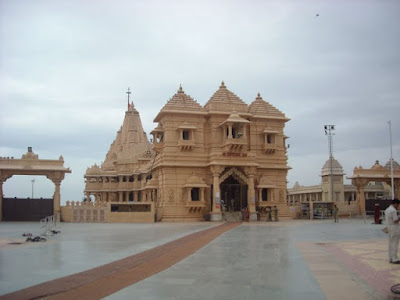 Somnath means "The Protector of Moon God". The Somnath Temple is known as 'the Shrine Eternal', as although the temple has been destroyed six times it has been rebuilt every single time. 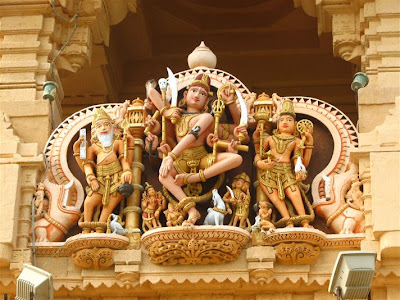 Brahma, one of the trinity, installed the Brahmashila, and paved way for the construction of the temple. On the request of the Chandrama and other gods Bhagwan Shankar assumed the name Somchandra (Jyotirlinga) and resided there eternally. He became famous by the name Somnath in the three worlds. Since, it was the Prabhas Kshetra where Bhagwan Shri Krishna performed all his Lilas. In this temple there is a small cave in which a lamp burns continuously.  The Skanda Purana describes the Sparsa Linga of Somnath as one bright as the sun, the size of an egg, lodged underground. The Mahabharata also refers to the Prabhasa Kshetra and the legend of the moon worshipping Shiva. 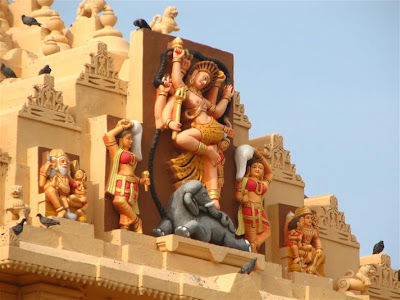 Ransacking and Rebuilding of Somnath Jyotirlinga The present temple is the seventh temple reconstructed on the original site. The first temple of Somnath is said to have existed before the beginning of the Christian era. The second temple, built by the Maitraka kings of Vallabhi in Gujarat, replaced the first one on the same site around 649. In 725 Junayad, the Arab governor of Sind, sent his armies to destroy the second temple. The Pratihara king Nagabhata II constructed the third temple in 815, a large structure of red sandstone. In 1024, Mahmud Ghazni raided the temple from across the Thar Desert. During his campaign, Mahmud was challenged by Ghogha Rana, who at the ripe age of 90, sacrificed his own clan fighting against this iconoclast. The temple and citadel were ransacked, and more than 50,000 defenders were massacred; Mahmud personally hammered the temple's gilded lingam to pieces and the stone fragments were carted back to Ghazni, where they were incorporated into the steps of the city's new Jamiah Masjid (Friday mosque). The fourth temple was built by the Paramara King Bhoj of Malwa and the Solanki king Bhima of Gujarat (Anhilwara) or Patan between 1026 and 1042. The wooden structure was replaced by Kumarpal who built the temple of stone. The temple was razed in 1297 when the Sultanate of Delhi conquered Gujarat, and again in 1394. The Mughal Emperor Aurangzeb destroyed the temple again in 1706. Sardar Vallabhbhai Patel, then Home Minister & the first Deputy Prime Minister of India took a pledge on November 13, 1947 for its reconstruction for the seventh time. A mosque present at that site was shifted few miles away. It was completed on December 1, 1995 and President of India, Dr. Shankar Dayal Sharma dedicated it in the service of the nation. The present temple was built by the Shree Somnath Trust which looks after the entire complex of Shree Somnath and its environs. 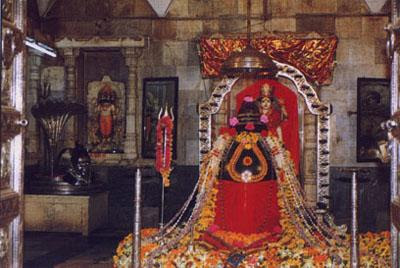 The following extract is from "Wonders of Things Created, and marvels of Things Existing" by Asaru-L Bilad, a 13th century Muslim geographer.It contains the following description of Somnath temple and its destruction: The following is a long quotation: "Somnath: celebrated city of India, situated on the shore of the sea, and washed by its waves. Among the wonders of that place was the temple in which was placed the idol called Somnat. This idol was in the middle of the temple without anything to support it from below, or to suspend it from above. It was held in the highest honor among the Hindus, and whoever beheld it floating in the air was struck with amazement, whether he was a Musulman or an infidel 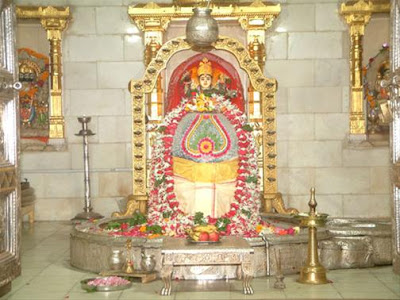 The Hindus used to go on pilgrimage to it whenever there was an eclipse of the moon, and would then assemble there to the number of more than a hundred thousand. They believed that the souls of men used to meet there after separation from the body, and that the idol used to incorporate them at its pleasure in other bodies, in accordance with their doctrine of transmigration. "The ebb and flow of the tide was considered to be the worship paid to the idol by the sea. 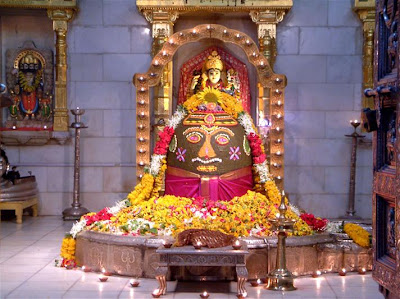 Everything of the most precious was brought there as offerings, and the temple was endowed with more than 10,000 villages. There is a river (the Ganges) which is held sacred, between which and Somnat the distance is 200 parasangs.They used to bring the water of this river to Somnat every day, and wash the temple with it. A thousand brahmans were employed in worshipping the idol and attending on the visitors, and 500 damsels sung and danced at the door–all these were maintained upon the endowments of the temple. 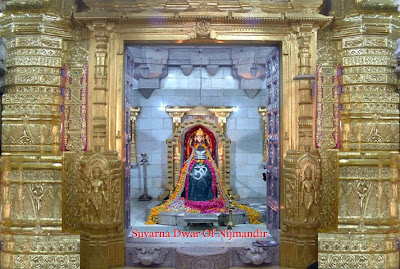 The edifice was built upon fifty-six pillars of teak, covered with lead. The shrine of the idol was dark. hut was lighted by jeweled chandeliers of great value. Near it was a chain of gold weighing 200 mans. When a portion (watch) of the night closed, this chain used to be shaken like bells to rouse a fresh lot of brahmans to perform worship. 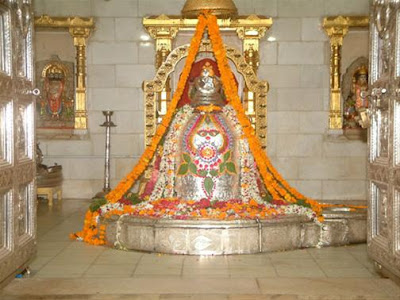 "When the Sultan Yaminu-d Daula Mahmud Bin Subuktigin went to wage religious war against India, he made great efforts to capture and destroy Somnat, in the hope that the Hindus would then become Muhammadans. He arrived there in the middle of Zi-l k'ada, 416 A.H. (December, 1025 A.D.). "The king looked upon the idol with wonder, and gave orders for the seizing of the spoil, and the appropriation of the treasures. There were many idols of gold and silver and vessels set with jewels, all of which had been sent there by the greatest personages in India. The value of the things found in the temples of the idols exceeded twenty thousand thousand dinars. 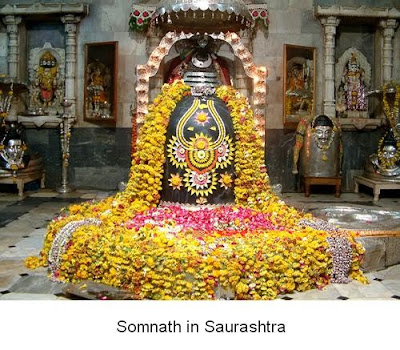 (Elliot's footnote: The enormous treasures found at Somnat have been a theme of wonder for all who have written on that conquest.) "When the king asked his companions what they had to say about the marvel of the idol, and of its staying in the air without prop or support, several maintained that it was upheld by some hidden support. The king directed a person to go and feel all around and above and below it with a spear, which he did, but met with no obstacle. One of the attendants then stated his opinion that the canopy was made of loadstone, and the idol of iron, and that the ingenious builder had skillfully contrived that the magnet should not exercise a greater force on anyone side-hence the idol was suspended in the middle. Some coincided, others differed. Permission was obtained from the Sultan to remove some stones from the top of the canopy to settle the point. When two stones were removed from the summit the idol swerved on one side, when more were taken away it inclined still further, until at last it rested on the ground." May the Jyothirlinga of Shri Somnath temple remove all the negative energies with in us and inspire us to be a better human being.  Tomb of Sultan Mahmud of Ghazni, in 1839-40, showing the replicas of original Sandalwood Doors at Somnath, which he destroyed in ca 1024 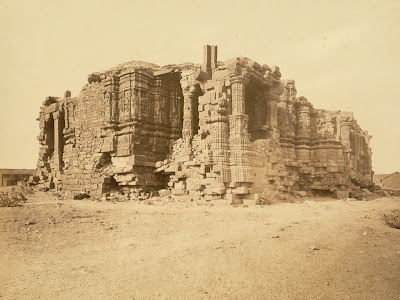 Ruins of somnath temple from 1869  Inside view of Somnath in 1869 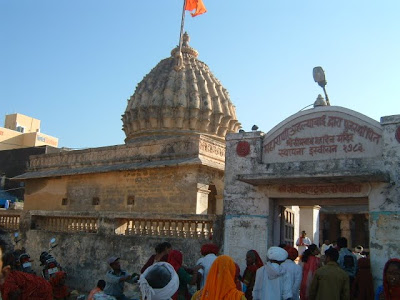 Ahilyabai's Somnath Temple or Old Somnath Temple: This temple is adjacent to present temple. As the main Somnath temple witnessed series of attacks and destruction in the medieval period, Maharani Holkar who was a great devotee of Lord Shiva built this temple in 1783. She felt that the older place was inauspicious as there were series of attacks. She built the temple in basement as a security measure. Above it on the ground a small temple of Lord Shiva is built. Unlike the new, there is no restriction on puja by devotee in this temple. So, many can be seen performing puja here. It is known as old Somnath temple and it is also managed by Shri Somnath Trust. 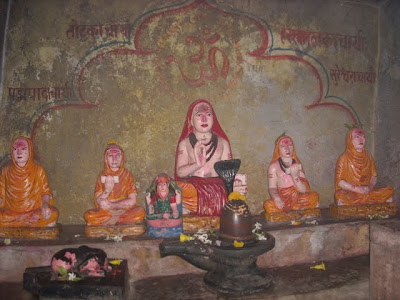 Adi Guru Shankaracharya Gufa 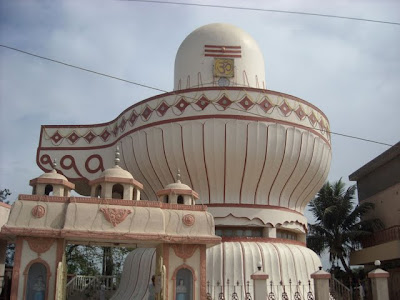 Bramkumari temple around Somnath 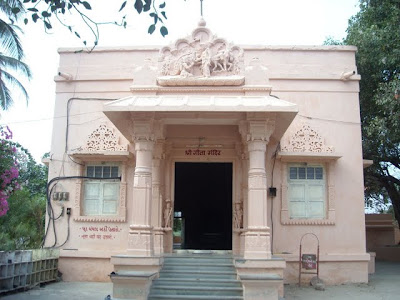 Gita Mandir Gita Mandir
Gita Mandir campus comprises of Gitamandir,Balaramji ni gufa, Laxminarayan Temple, Dehotsarga place,Shri Kashi Vishwanath Temple, Mahaprabhuji Baithak and Bhimnath Mahadev Temple. Gita temple, also known as Birla temple, is marvelous architectural beauty in Marbles. The images of Gita Hymns are depicted in the inscriptions of marble walls. The temple is constructed in such a way that one can hear the echo of his voice inside the temple, so that the Krishna bhajans by the devotees can be echoed in the environments 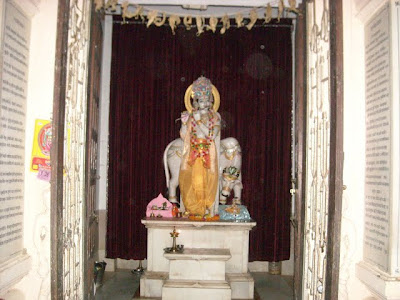 Krishna Mandir 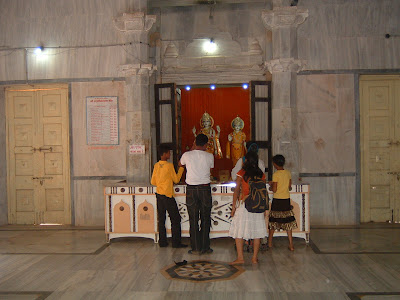 Laxminarayan Temple 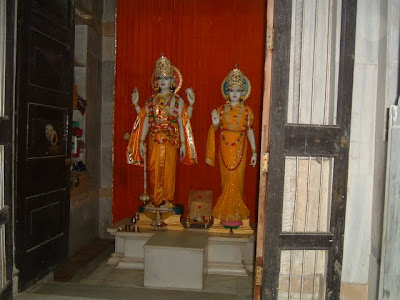 May Shree Laxmi Narayan of Somnath bless our souls.. May Shree Laxmi Narayan of Somnath bless our souls..
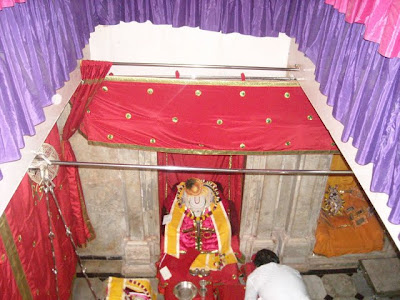 Mahaprabhuji Baithak  Balaramji ni gufa 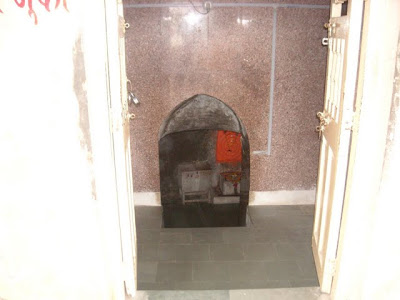 Balaramji ni gufa 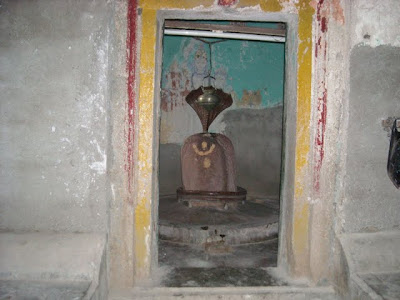 Bhimeshwar temple / Panch Pandav ni Gufa /Bhimnath Mahadev Temple : Panch Pandava Gufa is a temple situated near Lalghati in Somnath. Late Baba Narayandas founded it in the year 1949. This temple is dedicated to five Pandava brothers. This temple at an elevated place, offers a beautiful view of surrounding holy city. 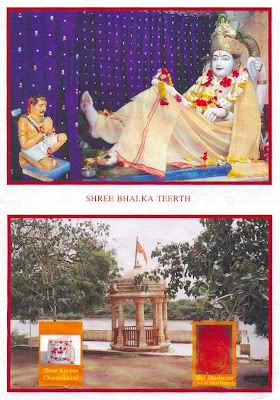 Bhalka Tirtha: There is a beautiful idol of Lord Shri Krishna in meditating form. The pippal tree is also seen outside the main temple. Near the main temple is Mahadev temple. This is the place where the arrow of Jara poacher hit Lord Krishna while he was meditating under a peepal tree. He had taken the shining mark of the foot of Lord Krishna and shot arrow. Lord Krishna pardoned Jara and walked away to the bank of Hiren river and left the mundane world.This sacred tirtha is located 5 km on Prabhaspatan- Veraval road. 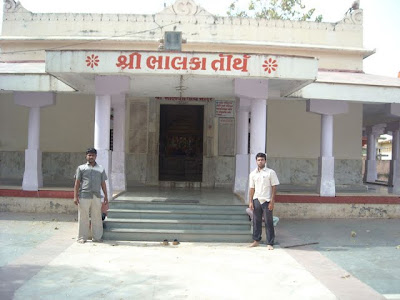 Bhalka Teerth, where Lord Krishna was shot on the feet by Jara, the Bhil hunter 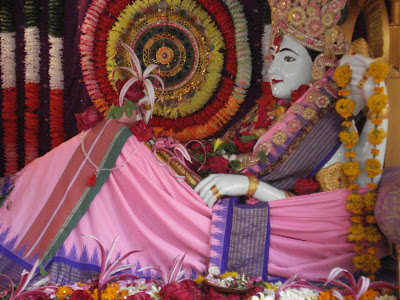 This divined leela of Bhagvan Shree Krishna is immortalised by a beautiful temple and an ancient pippal tree. Bhagvan Shree Krishna then walked a small distance and arrived at the holy banks of river Hiran from where he took his last journey to his Neejdham. 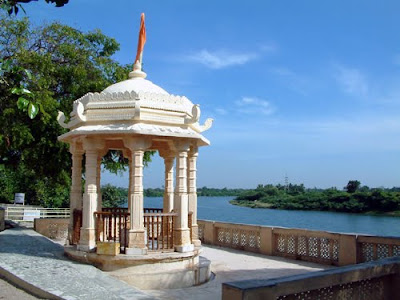 Shree Krishna Neejdham Prasthan Tirth(DEHOTSARG TEERTH) Shree Krishna Neejdham Prasthan Tirth(DEHOTSARG TEERTH)
This Tirtha is located on the banks of Hiran at a distance of 1.5km from Somnath temple. Bhagvan Shree Krishna took his divine journey to Neejdham from this sacred soil. Rich accounts of the divined Shree Krishna Neejdham Prasthan Leela are maintained by the authentic traditions of Mahabhart, Shrimad Bhagwat, and Vishnu Puran etc. Swami Shri Gajananand Saraswatiji has critically examined the previously mentioned classical Indian traditions and suggested the time of Neejdham Prasthan. He suggested that Shri Krishna departed on the first day of bright fortnight of Chaitra month (which corresponds with 18 February of English calendar) in the year 3102 B.C. at 2:27:30 hours 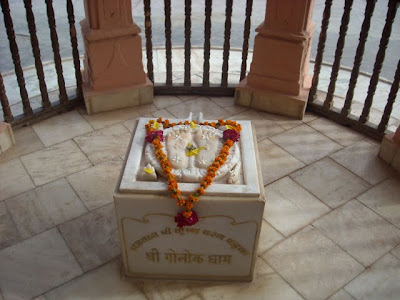 The footprint of Bhagvan Shree Krishna is carved here to mark the divine memory of Shree Krishna Neejdham Prasthan Leela. Baldevji, the elder brother of Shree Krishna also took his last journey from here in his original serpent form. This is marked by an ancient holy cave called "Dauji-ni Gufa" May Lord Krishna show us all the path that leads to goodness and to the abode of God which is Heaven
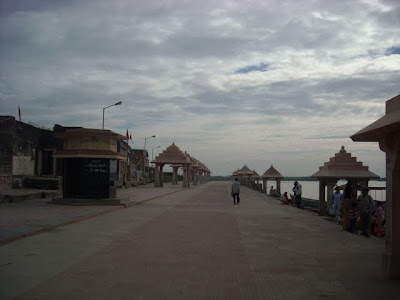 Treeveni Sangam Snanghat Treeveni Sangam Snanghat Triveni Ghat in Somanth is the confluence of three holy rivers Kapil, Hiran and a mystical River Saraswaty(also known as Gupt Saraswati). It is believed that the rivers flow to the ultimate destination of Sea from here. This symbolises the human birth, life and death. This is a sacred place. It is believed that the bath in the waters at this Ghat offers relief from all curses and ills happened It is an important place to pay homage to ancestors, Pitrutarpan. as it holds high religious importance for tarpan for the ancestors. In Chaitra and Bhadrapada months of Hindu calendar huge crowds are seen here. In Hindu mythology feeding fish is regarded as a talisman for getting wealth and prosperity. People can be seen feeding fish here. 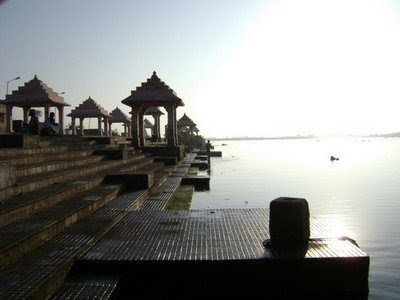 May the sacred waters of Treeveni Sangam Ghat purify our souls and wash away all our sins and bad memories of our past. May the sacred waters of Treeveni Sangam Ghat purify our souls and wash away all our sins and bad memories of our past. Sai bhakt, Deepa H   |
For Daily SAI SANDESH
Join our Group today
Click at our Group address :
http://groups.google.co.in/group/shirdikesaibaba
Current email address :
shirdikesaibaba@googlegroups.com
Also visit us at :
http://shirdikesaibabaji.blogspot.com
|
|
|
 Primer
Primer
 Anterior
2 a 2 de 2
Siguiente
Anterior
2 a 2 de 2
Siguiente
 Último
Último

|
|
|
|
De: becket |
Enviado: 20/08/2023 08:33 |
Discover comprehensive information inside Indian Encyclopedia. Explore diverse topics, from history to culture, while in the Indian Encyclopedia. Uncover insights that span generations inside Indian Encyclopedia. Look into the richness of India's heritage while using the Indian Encyclopedia. Your ultimate resource for knowledge: the Indian Encyclopedia. |
|
|
|
|
| |
|
|
©2026 - Gabitos - Todos los derechos reservados | |
|
|
